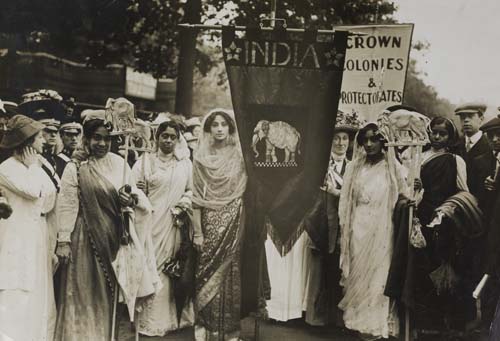About this object
-
ID:
50.82/1653
Production date:
1911-06-17
-
Location:
In Store
-
This image depicts representatives from London's female Indian community taking part in the Women's Coronation Procession of 17 June 1911. This event was organised by the militant Suffragette organisation, the Women's Social & Political Union. Held a week before the coronation of George V, it was intended to enlist the support of the new King for the Conciliation Bill being debated in Parliament that would have granted limited female suffrage. The small Indian contingent of the Procession was organised by Mrs Jane Fisher Unwin (the daughter of Richard Cobden). She and other representatives of the WSPU contacted Indian women living in the UK in the weeks leading up to the procession, organised the decorations and the collection of subscriptions for the elephant banner that cost between £4 and £5. The India contingent was part of the 'Imperial Pageant' and intended to show the strength of support for women's suffrage throughout the Empire. To the left of the banner is Lolita Roy, dressed in white. Lolita moved from India to Hammersmith, London with her children in 1901. A supporter of female suffrage in India she became President of the London Indian Union Society. One of young women in the image is Lolita's daughter, Mrs. Leilavati Mukerjea. On the far left, holding the elephant pennant is Mrs Bhagwati Bhola Nauth. All corners of the empire were represented in the Imperial Pageantand divided into 6 sections - New Zealand, Australia, Canada, South Africa, Crown Colonies and Protectorates and India. Annie Besant also took part in the India procession.
< ...Read more -
Measurements
H 147 mm; W 214 mm (overall)
-
Materials
paper; ink
-
Last Updated
2024-04-19
Record quality:
Not every record in Collections Online is complete. Some have low quality images designed purely for recognition, while some have been catalogued only to a basic standard. This graphic is designed to give you an impression of the quality of data you can see. 100% meets all our current data standards and has a high quality image, 20% is a basic record with no image. Individual record quality can change over time as new photography is carried out and records are worked on.
X







